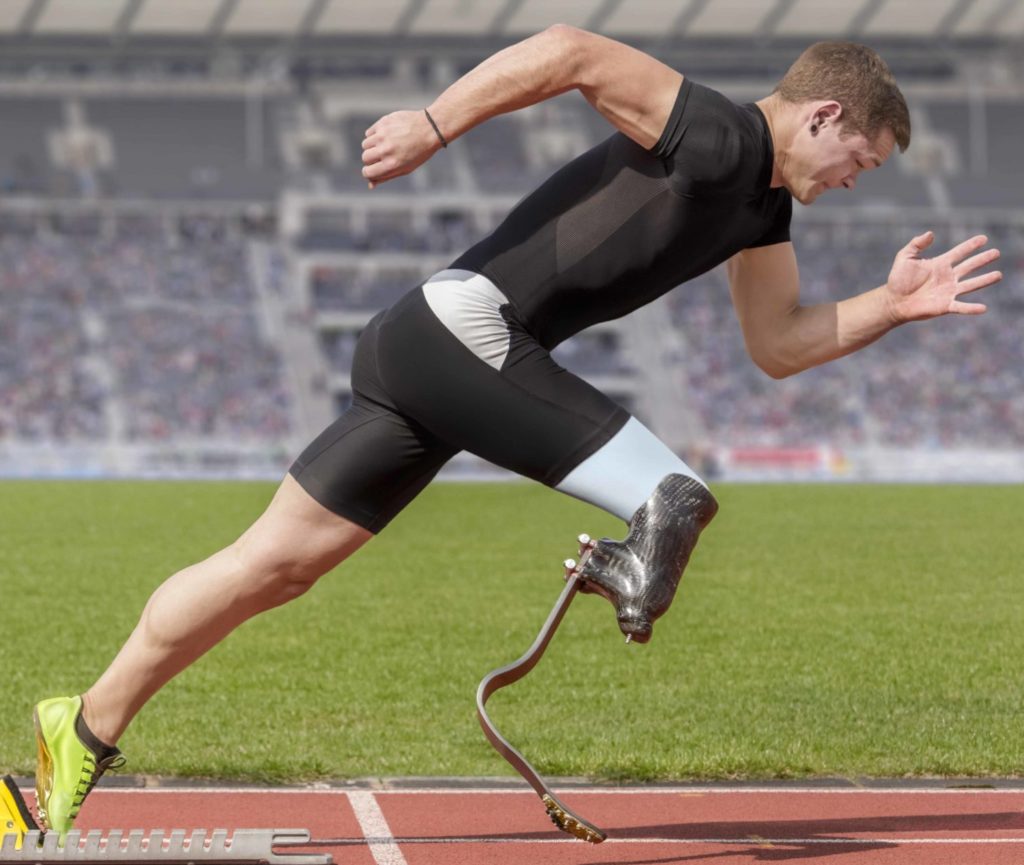Strong Hamstrings for Safe Sprinting

Take Home Message
1. Hamstring injuries are the most common injury in sports that involve fast running
2. The major risk factors for hamstring injury are previous hamstring injuries, age and running while fatigued
3. Strengthening the hamstring using eccentric resistance training has been shown to significantly reduce both the frequency and severity of hamstring injuries
4. A holistic sprint training program should include exercises that (1) increase hamstring eccentric strength, (2) increase hamstring maximal strength, (3) increase hamstring strength-endurance and (4) improve hamstring mobility
5. Finally, you must include some form of progressive sprint training to specifically condition your hamstrings for running fast
The Dreaded Hamstring Tear
Running fast in an essential part of sport and life. Unfortunately, for those of us who are older, have experienced a previous hamstring injury, or are running in a fatigued state, the risk of incurring a hamstring injury while running quickly is high 1.
Serious hamstring injuries may require months of rehabilitation. Avoiding hamstring injuries is therefore critically important not only for athletes, but also for professionals within the military, law enforcement and emergency services who run fast as part of their job.
In this article I outline the approach I used to rehabilitate and strengthen my hamstrings so I can sprint without injury. I hope some of this information informs your own approach to sprint training.
How common are hamstring injuries in sport?
Hamstring injuries are the most common injury in sports that involve running fast.
This fact is made abundantly clear in the literature. For example:
– Hamstring injuries account for around 25% of all injuries in athletics 2.
– In soccer, hamstring injuries account for 12% of all injuries 3.
– In rugby union hamstring injuries are the most common non-impact injury experienced by players 4.
– Hamstring strains make up a significant amount of injuries in the American NFL 5.
– In Gaelic football, hamstring injuries account for 24% of all injuries 6.
– Finally, hamstring injuries are the most common injury in Australian football, causing the highest number of missed games of all injury types 7.
If you have suffered a hamstring injury while sprinting, you are not alone. The good news is that there is a clinically proven approach to reduce both the frequency and severity of hamstring injuries.
Why are hamstring injuries so common?
Most sport-related hamstring tears occur while sprinting 8.
Eccentric contraction is when a muscle contracts while being stretched. When your front leg swings forward while you run, your hamstring forcefully contracts while stretching to reverse your forward leg swing 9. The faster you are running, the harder your hamstring must contract in order to reverse the momentum of your leg 10.
It is here, when the hamstring is contracting while being stretched, that most sprint-related hamstring injuries occur 11,12.
Making the hamstring stronger during eccentric contraction protects the hamstring during sprinting.
This is because when your hamstrings become stronger in the most injury-prone position, they are less likely to tear. Period.
Importantly, this is true across all sports, sexes and ages.
The Nordic Hamstring Exercise (NHE)
The exercise with the most clinical support for hamstring injury prevention is the Nordic Hamstring Exercise (NHE) or Nordic Hamstring Curl 13,14. The sole purpose of the NHE is to strengthen the hamstrings while they are undergoing eccentric contraction.
The simplest form the NHE is a partner-assisted exercise, where the person performing the NHME begins in a kneeling position and drops toward the ground, with the partner pushing down on the ankles to anchor the person in place.
The idea is to slowly lower yourself to the ground under control by forcefully contracting the hamstrings to resist the downward motion. When you approach ground use your hands to push yourself back to the starting position.
Scientific studies have consistently shown that the NHE reduces the incidence and severity of hamstring injuries. This was first shown in a randomised controlled trial undertaken in professional and amateur soccer players, inclusion of the NHE decreased the rate of new injuries by more than 60% and, very importantly, reduced the rate of hamstring re-injury by approximately 85% 15.
Multiple clinical trials subsequently confirmed that, when participants are compliant with eccentric hamstring strengthening, there is a 65% decreased risk of hamstring injury 13. When the NHE was introduced into a variety of different sport training programs, the rate of hamstring injuries decreased by around 50% 14.
Importantly, the effectiveness of the NHE to reduce the frequency and severity of hamstring injuries holds true despite differences in age, gender and the type of sport 14.
How to Program the NHE
Frequency
Training the NHE twice a week is optimal and including the NHE even once a week improves eccentric hamstring strength 16.
It’s important to take a conservative, progression-based approach to NHE training. Why? Because eccentric exercise-induced muscle damage causes short-term decreases in strength and power, jump height, sprint speed, balance, agility and range of motion 17.
For these reasons, training the NHE too frequently will decrease performance while increasing the risk of injury. As this is the exact opposite of what you are trying to achieve, you should train the NHE no more than twice a week.
If you are already engaged in a sport that involves fast running, it is best to schedule your NHE workouts so that you are not sprinting the following day. Program the NHE so that you have enough time to recover from the fatigue and muscle damage induced by eccentric training before you engage in sprinting.
Volume
Both high and low volume NHE volume produces large improvements in eccentric strength over a minimum duration of 6 weeks 18. Thus, from a strength standpoint, there is no reason to use high volumes for this exercise.
In fact, a low NHE volume is optimal as eccentric training is extremely fatiguing. A single set of five NHE repetitions leads to significant fatigue, which is not alleviated by resting between sets 19.
Further, eccentric training also induces significant muscle damage and high levels of delayed onset muscle soreness (DOMS) 18. Eccentric exercise‒induced muscle damage peaks three days after exercise and can take up to a week for the trained muscle to return to normal 20.
High-volume NHE causes both high levels of muscle soreness and high levels of muscle fatigue for no appreciable gain in training effect 19. To avoid the negative training effects of eccentric exercise, you should keep your volume low.
Our recommendation is to begin with two sets of five reps performed twice per week, using an assisted variation of the NHE that you can perform safely using good form.
Once your body has adapted to the exercise (i.e. you are not sore and your execution of the NHE is solid for all ten repetitions), increase the number of sets to three.
Intensity
The NHE is a challenging exercise. In fact, performing unassisted NHE repetition is too difficult for most athletes 21. It is therefore highly recommended that most people begin using an assisted variation of the NHE that allows them to complete the NHE safely using a slow, controlled tempo throughout the movement.
The NHE intensity can be incrementally increased as strength improves. NHE intensity is increased by moving from assisted NHE variations to the unassisted NHE, then incrementally decreasing the speed of descent.
Eventually, you may get strong enough to pause at different stages of the exercise or even complete repetitions without using the arm-assisted push-off from the bottom. At this stage consider adding additional weight to make the exercise more challenging.
This is a simple application of the principle of progressive overload, an approach that is recommended for all strength training programs 18. Put simply, start light, then gradually increase the difficulty of the exercise as you get stronger.
Using the Standard Hamstring Curls Machine for Eccentric Hamstring Training
Unfortunately, the NHE is tedious to set up when training by yourself, it is a difficult exercise for most people to do, and the assisted versions of the NHE are even more painful to set up and execute.
For these reasons, consider using the hamstring curl machine to perform eccentric hamstring training.
The standard hamstring curl, an exercise station that is ubiquitous in gyms around the world, can easily be used to perform eccentric hamstring curls. As two legs are stronger than one, you simply use two legs to raise the weight, then lower the weight eccentrically using a single leg.
The hamstring curl is a machine, so a detailed explanation of exercise performance is not required. Just be sure to set up the hamstring curl so that you are using a full range of motion, lowering the weight under control for a three-to-five second count. Ensure that you finish in a neutral position to avoid over-stretching the hamstring.
One working set consists of alternating left-leg/right-leg repetitions, using five repetitions per leg, for a total of ten repetitions.
The programming considerations for the eccentric hamstring curl are exactly the same as for the NHE.
I personally prefer the eccentric hamstring curl over the NHE. This is because it’s easy to select a weight that is both safe and effective throughout the full range of motion, it’s simple to progressively increase weight over time, and it’s very convenient for people who train alone.
Holistic Hamstring Training
Eccentric hamstring training clearly has a central place in training programs designed to prevent sprinting-related hamstring injury.
Maximal Strength
That said, many sports involve rapid acceleration and changes of direction, combined with high running loads performed in a fatigued state. These physical demands require a holistic program that not only increase hamstring eccentric strength, but also develops maximal hamstring strength, hamstring strength-endurance and hamstring mobility 22.
Ideally you should increase the maximal strength of your posterior chain across multiple angles using exercises such as conventional deadlifts, heavy hip-thrusters, back extensions, heavy hamstring curls, kettle bell swings and many others.
Just pick one or two proven posterior chain exercises and have at it.

Always follow a strength and conditioning program that is firmly grounded on the principles of progressive overload. And remember that proper lifting technique and bracing are mandatory when lifting heavy weights.
Strength-endurance
Strength-endurance is an important characteristic to protect against fatigue related injuries during sport. This type of training involves moving moderately heavy weights for rep ranges between 20-50 repetitions.
My favourite hamstring exercise for strength-endurance is single-legged hip thrusters, performed for three sets of 20 repetitions. These are NOT done for booty augmentation, so don’t pause at the top. Keep the repetitions going at a fast-yet-controlled pace and complete each repetition using a full range of motion. Make sure that you engage both the hamstring and glute muscles.
You can also use back extension, kettle bell swings, Romanian deadlifts, hamstring curls and so on.
If you have access to one, Prowler sprints are fantastic for improving anaerobic conditioning and building strength-endurance in the posterior chain. This is a highly recommended exercise.
As usual, start light, maintain good form throughout all your working sets and apply the principles of progressive overload.
Mobility
You should always start your workouts with dynamic mobility warm-ups and end your workouts with static stretching as part of your cool down.
I am certainly no mobility guru, but it’s hard to go wrong using gentle, consistent stretching while staying within your mobility limitations.
Muscle tears caused by over-stretching are bad news, so don’t stretch beyond your mobility limits. A little stretching done often is the way to go.
The Need for Progressive Sprint Training
Protecting yourself from hamstring injury will ultimately require you to regularly incorporate some type of progressive sprint training into your training program 22. Progressive sprint training allows your body to gradually adapt to the specific demands of running quickly. Again, start light and gradually increase the intensity over time.
Conclusion
Eccentric hamstring training is a proven method to reduce hamstring injury during sports that involve fast running.
Eccentric training should be performed twice a week, starting with low volume and intensity that allows you to gradually increasing the exercise difficulty over time.
A holistic hamstring program should also include exercises that increase hamstring maximal strength, hamstring strength-endurance and hamstring mobility.
Finally, incorporating an appropriately programmed sprint training program is critical for conditioning your body for the specific demands of fast running.
References
1 Opar, D. A., Williams, M. D. & Shield, A. J. Hamstring strain injuries: factors that lead to injury and re-injury. Sports Med 42 (2012).
2 Opar, D. A. et al. Acute hamstring strain injury in track‐and‐field athletes: A 3‐year observational study at the Penn Relay Carnival. Scand J Med Sci Sports 24 (2014).
3 Ekstrand, J., Hägglund, M. & Waldén, M. Epidemiology of Muscle Injuries in Professional Football (Soccer). The American Journal of Sports Medicine 39, 1226-1232 (2011).
4 Brooks, J. H. M., Fuller, C. W., Kemp, S. P. T. & Reddin, D. B. A prospective study of injuries and training amongst the England 2003 Rugby World Cup squad. Br J Sports Med 39, 288-293 (2005).
5 Brophy, H. R. et al. Predictive Value of Orthopedic Evaluation and Injury History at the NFL Combine. Medicine & Science in Sports & Exercise 40, 1368-1372 (2008).
6 Murphy, J. C., O’Malley, E., Gissane, C. & Blake, C. Incidence of injury in Gaelic football: a 4-year prospective study. The American journal of sports medicine 40, 2113-2120 (2012).
7 Orchard, J. W., Seward, H. & Orchard, J. J. Results of 2 Decades of Injury Surveillance and Public Release of Data in the Australian Football League. The American Journal of Sports Medicine 41, 734-741 (2013).
8 Brooks, J. H. M., Fuller, C. W., Kemp, S. P. T. & Reddin, D. B. Incidence, risk, and prevention of hamstring muscle injuries in professional rugby union. The American journal of sports medicine 34, 1297-1306 (2006).
9 Thelen, D. G., Chumanov, E. S., Best, T. M., Swanson, S. C. & Heiderscheit, B. C. Simulation of biceps femoris musculotendon mechanics during the swing phase of sprinting. Med Sci Sports Exerc 37, 1931-1938 (2005).
10 Chumanov, E. S., Heiderscheit, B. C. & Thelen, D. G. The effect of speed and influence of individual muscles on hamstring mechanics during the swing phase of sprinting. J Biomech 40, 3555-3562 (2007).
11 Heiderscheit, B. C. et al. Identifying the time of occurrence of a hamstring strain injury during treadmill running: a case study. Clin Biomech (Bristol, Avon) 20, 1072-1078 (2005).
12 Chumanov, E. S., Heiderscheit, B. C. & Thelen, D. G. Hamstring musculotendon dynamics during stance and swing phases of high-speed running. Med Sci Sports Exerc 43, 525-532 (2011).
13 Goode, A. P. et al. Eccentric training for prevention of hamstring injuries may depend on intervention compliance: a systematic review and meta-analysis. Br J Sports Med 49, 349-356 (2015).
14 van Dyk, N., Behan, F. P. & Whiteley, R. Including the Nordic hamstring exercise in injury prevention programmes halves the rate of hamstring injuries: a systematic review and meta-analysis of 8459 athletes. Br J Sports Med 53, 1362-1370 (2019).
15 Petersen, J., Thorborg, K., Nielsen, M. B., Budtz-Jørgensen, E. & Hölmich, P. Preventive Effect of Eccentric Training on Acute Hamstring Injuries in Men’s Soccer: A Cluster-Randomized Controlled Trial. The American Journal of Sports Medicine 39, 2296-2303 (2011).
16 Vatovec, R., Kozinc, Ž. & Šarabon, N. Exercise interventions to prevent hamstring injuries in athletes: A systematic review and meta-analysis. Eur J Sport Sci, 1-13 (2019).
17 Milanese, S. & Eston, R. Hamstring injuries and Australian Rules football: over-reliance on Nordic hamstring exercises as a preventive measure? Open Access J Sports Med 10, 99-105 (2019).
18 Cuthbert, M. et al. The Effect of Nordic Hamstring Exercise Intervention Volume on Eccentric Strength and Muscle Architecture Adaptations: A Systematic Review and Meta-analyses. Sports Med 50, 83-99 (2020).
19 Alt, T., Nodler, Y. T., Severin, J., Knicker, A. J. & Strüder, H. K. Comment On: “The Effect of Nordic Hamstring Exercise Intervention Volume on Eccentric Strength and Muscle Architecture Adaptations: A Systematic Review and Meta-Analyses”. Sports Med 50, 219 (2020).
20 Isner-Horobeti, M.-E. et al. Eccentric exercise training: modalities, applications and perspectives. Sports Med 43, 483-512 (2013).
21 Marshall, P. W. M., Lovell, R., Knox, M. F., Brennan, S. L. & Siegler, J. C. Hamstring Fatigue and Muscle Activation Changes During Six Sets of Nordic Hamstring Exercise in Amateur Soccer Players. J Strength Cond Res 29 (2015).
22 Oakley, A. J., Jennings, J. & Bishop, C. J. Holistic hamstring health: not just the Nordic hamstring exercise (BMJ Publishing Group Ltd and British Association of Sport and Exercise Medicine, 2018).
Disclaimer
The material displayed on this website is provided without any guarantees, conditions or warranties as to its accuracy.
Information written and expressed on this website is for education purposes and interest only. It is not intended to replace advice from your medical or healthcare professional.
You are encouraged to make your own health care choices based on your own research and in conjunction with your qualified practitioner.
The information provided on this website is not intended to provide a diagnosis, treatment or cure for any diseases. You should seek medical attention before undertaking any diet, exercise, other health program or other procedure described on this website.
To the fullest extent permitted by law we hereby expressly exclude all warranties and other terms which might otherwise be implied by statute, common law or the law of equity and must not be liable for any damages whatsoever, including but without limitation to any direct, indirect, special, consequential, punitive or incidental damages, or damages for loss of use, profits, data or other intangibles, damage to goodwill or reputation, injury or death, or the cost of procurement of substitute goods and services, arising out of or related to the use, inability to use, performance or failures of this website or any linked sites and any materials or information posted on those sites, irrespective of whether such damages were foreseeable or arise in contract, tort, equity, restitution, by statute, at common law or otherwise.

Ten Minutes is All You Need
Research has shown that ten minutes of moderate-to-vigorous exercise performed each day is enough to significantly reduce your risk of early death.

Psychological Resilience in the Pandemic Age
It’s the combination of physical, psychological and spiritual practice that maximises your resilience during the pandemic age.




